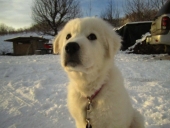
 8
8




"People may doubt what you say, but they will believe what you do."
 2
2




Zone 5/6
Annual rainfall: 40 inches / 1016 mm
Kansas City area discussion going on here: https://www.facebook.com/groups/1707573296152799/
 3
3





"People may doubt what you say, but they will believe what you do."
 1
1




 2
2




Todd Parr wrote: One issue I think you may have is that it's pretty hard to tell who is laying best. I don't really have a way to tell with my ladies. They share the nest boxes and the only eggs that are really easy to tell are the Easter Eggers.
'What we do now echoes in eternity.' Marcus Aurelius
How Permies Works Dr. Redhawk's Epic Soil Series
 2
2




A human being should be able to change a diaper, plan an invasion, butcher a hog, conn a ship, design a building, write a sonnet, balance accounts, build a wall, set a bone, comfort the dying, take orders, give orders, cooperate, act alone, solve equations, analyze a new problem, pitch manure, program a computer, cook a tasty meal, fight efficiently, die gallantly. Specialization is for insects.
-Robert A. Heinlein

 1
1




List of Bryant RedHawk's Epic Soil Series Threads We love visitors, that's why we live in a secluded cabin deep in the woods. "Buzzard's Roost (Asnikiye Heca) Farm." Promoting permaculture to save our planet.




"People may doubt what you say, but they will believe what you do."
 8
8




 1
1




"People may doubt what you say, but they will believe what you do."




Todd Parr wrote:Brandon, what area are you in?

 5
5








Joseph Lofthouse wrote:
Brandon, Good job!
One thing I think about a lot with chickens, is how much of the chicken's behavior is genetic, and how much of it is socialization... I say that, because we have a pheasant farm here, and the birds released from the farm for hunters are the stupidest birds I ever saw in my life. I attribute that to being raised in an incubator, and being raised devoid of traditional pheasant society. I suspect that if you catch some of the chickens as day-old birds, and separate them from chicken society at birth, that you may lose many of the traits that make them particularly well suited to your farm. I think that they are not just genetics, they are a combination of genetics and society.












 1
1




List of Bryant RedHawk's Epic Soil Series Threads We love visitors, that's why we live in a secluded cabin deep in the woods. "Buzzard's Roost (Asnikiye Heca) Farm." Promoting permaculture to save our planet.
























List of Bryant RedHawk's Epic Soil Series Threads We love visitors, that's why we live in a secluded cabin deep in the woods. "Buzzard's Roost (Asnikiye Heca) Farm." Promoting permaculture to save our planet.
 2
2




Wes Hunter wrote:I question the actual usefulness of a 'camouflage' feather pattern. The idea makes sense, and I used to think it was important too, but now I wonder.
.)
 1
1










"People may doubt what you say, but they will believe what you do."












 1
1




 2
2




 1
1




 3
3








Todd Parr wrote:I've been working towards a "landrace" chicken that thrives here in WI. It needs to be cold-hardy, have a small comb to prevent frostbite, be able to handle our hot, humid summers, and preferably have a darker, mottled pattern to help protect against predators. I'm 4 generations in to my project, and this year I have a chicken that fills all those needs really well. It has the dark pattern that I want, no comb to speak of, and comes from very winter-happy parents. I've found it hard to get a good picture of a chicken, so I apologize for the quality. I'll try to take some pictures that better show her off if people are interested.
 2
2




Earthworks are the skeleton; the plants and animals flesh out the design.





|
You ought to ventilate your mind and let the cobwebs out of it. Use this cup to catch the tiny ads:
Rocket Mass Heater Resources Wiki
https://permies.com/w/rmh-resources
|






